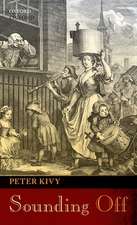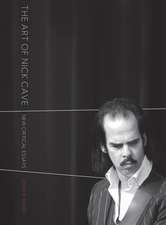Music, Modernity and Locality in Prewar Japan: Osaka and Beyond: SOAS Studies in Music
Editat de Alison Tokita, Hugh de Ferrantien Limba Engleză Hardback – 23 aug 2013
| Toate formatele și edițiile | Preț | Express |
|---|---|---|
| Paperback (1) | 471.25 lei 6-8 săpt. | |
| Taylor & Francis – 9 sep 2016 | 471.25 lei 6-8 săpt. | |
| Hardback (1) | 1006.57 lei 6-8 săpt. | |
| Taylor & Francis – 23 aug 2013 | 1006.57 lei 6-8 săpt. |
Din seria SOAS Studies in Music
-
 Preț: 341.08 lei
Preț: 341.08 lei - 9%
 Preț: 868.79 lei
Preț: 868.79 lei - 9%
 Preț: 936.95 lei
Preț: 936.95 lei -
 Preț: 311.18 lei
Preț: 311.18 lei -
 Preț: 310.03 lei
Preț: 310.03 lei - 9%
 Preț: 866.79 lei
Preț: 866.79 lei -
 Preț: 310.75 lei
Preț: 310.75 lei -
 Preț: 311.41 lei
Preț: 311.41 lei -
 Preț: 341.55 lei
Preț: 341.55 lei -
 Preț: 297.49 lei
Preț: 297.49 lei -
 Preț: 377.82 lei
Preț: 377.82 lei - 30%
 Preț: 768.69 lei
Preț: 768.69 lei - 18%
 Preț: 1121.01 lei
Preț: 1121.01 lei - 18%
 Preț: 1063.31 lei
Preț: 1063.31 lei - 25%
 Preț: 766.66 lei
Preț: 766.66 lei - 26%
 Preț: 765.43 lei
Preț: 765.43 lei - 18%
 Preț: 1060.25 lei
Preț: 1060.25 lei - 18%
 Preț: 1058.19 lei
Preț: 1058.19 lei - 18%
 Preț: 1063.41 lei
Preț: 1063.41 lei - 18%
 Preț: 1063.41 lei
Preț: 1063.41 lei - 28%
 Preț: 826.84 lei
Preț: 826.84 lei - 25%
 Preț: 823.17 lei
Preț: 823.17 lei - 18%
 Preț: 1053.16 lei
Preț: 1053.16 lei - 15%
 Preț: 239.96 lei
Preț: 239.96 lei - 18%
 Preț: 1050.09 lei
Preț: 1050.09 lei -
 Preț: 375.50 lei
Preț: 375.50 lei - 26%
 Preț: 766.24 lei
Preț: 766.24 lei - 26%
 Preț: 822.34 lei
Preț: 822.34 lei - 18%
 Preț: 1061.06 lei
Preț: 1061.06 lei - 26%
 Preț: 765.43 lei
Preț: 765.43 lei - 26%
 Preț: 765.43 lei
Preț: 765.43 lei - 25%
 Preț: 769.10 lei
Preț: 769.10 lei - 18%
 Preț: 1061.93 lei
Preț: 1061.93 lei - 30%
 Preț: 768.69 lei
Preț: 768.69 lei - 18%
 Preț: 1059.45 lei
Preț: 1059.45 lei - 26%
 Preț: 734.25 lei
Preț: 734.25 lei - 18%
 Preț: 1108.37 lei
Preț: 1108.37 lei - 18%
 Preț: 1051.55 lei
Preț: 1051.55 lei - 25%
 Preț: 767.88 lei
Preț: 767.88 lei - 25%
 Preț: 825.21 lei
Preț: 825.21 lei - 18%
 Preț: 1008.97 lei
Preț: 1008.97 lei - 26%
 Preț: 765.01 lei
Preț: 765.01 lei - 26%
 Preț: 764.36 lei
Preț: 764.36 lei - 18%
 Preț: 1005.04 lei
Preț: 1005.04 lei - 31%
 Preț: 765.04 lei
Preț: 765.04 lei - 18%
 Preț: 1068.15 lei
Preț: 1068.15 lei - 31%
 Preț: 763.93 lei
Preț: 763.93 lei
Preț: 1006.57 lei
Preț vechi: 1106.12 lei
-9% Nou
Puncte Express: 1510
Preț estimativ în valută:
192.61€ • 201.51$ • 159.100£
192.61€ • 201.51$ • 159.100£
Carte tipărită la comandă
Livrare economică 03-17 aprilie
Preluare comenzi: 021 569.72.76
Specificații
ISBN-13: 9781409411116
ISBN-10: 1409411117
Pagini: 332
Ilustrații: Includes 18 b&w illustrations, 3 maps and 4 musical examples
Dimensiuni: 156 x 234 x 19 mm
Greutate: 0.64 kg
Ediția:New ed.
Editura: Taylor & Francis
Colecția Routledge
Seria SOAS Studies in Music
Locul publicării:Oxford, United Kingdom
ISBN-10: 1409411117
Pagini: 332
Ilustrații: Includes 18 b&w illustrations, 3 maps and 4 musical examples
Dimensiuni: 156 x 234 x 19 mm
Greutate: 0.64 kg
Ediția:New ed.
Editura: Taylor & Francis
Colecția Routledge
Seria SOAS Studies in Music
Locul publicării:Oxford, United Kingdom
Notă biografică
Hugh de Ferranti’s published research is on historical and contemporary forms of biwa music, the practice of Japanese music beyond Japanese shores, and music-making among minorities in colonial era Japan. He is the author of Japanese Musical Instruments (OUP 2000) and The Last Biwa Singer (Cornell University East Asia Series 2009). He is Associate Professor in Music at the University of New England. Alison Tokita is Professor and Director of the Research Centre for Japanese Traditional Music at the Kyoto City University of Arts, and adjunct Associate Professor in Japanese Studies at Monash University. She has published widely on Japanese narrative music, and is currently working on naniwa-bushi. In recent years she has researched the role of the piano in East Asian musical modernity. She is co-editor of The Ashgate Research Companion to Japanese Music (Ashgate 2008), Complicated Currents: Media Flows, Soft Power and East Asia, and Outside Asia: Japanese and Australian Identities and Encounters in Flux.
Cuprins
I: Osakan Modernity: The Context; 1: Locating the Musics of Modern Osaka; 2: Aural Osaka: Listening to the Modern City; II: Creation of a Modern Musical Culture; 3: Marketing the Performing Arts in Osaka before the Twentieth Century; 4: The Growth of Western Art Music Appreciation in Osaka during the 1920s; 5: The Piano as a Symbol of Modernity in Prewar Kansai; III: Making and Remaking Music Traditions; 6: Naniwa-bushi and Social Debate in Two Postwar Periods: The Russo-Japanese War and the First World War; 7: Tateyama Noboru: Osaka, Modernity and Bourgeois Musical Realism for the Koto; 8: Modern Forms of Biwa Music in Osaka and the Kansai Region; 9: An Alternative Gagaku Tradition: The Gary?kai and Modern Osaka; IV: Hybridity in Kansai Musical Culture; 10: Takarazuka and Japanese Modernity; 11: Sh?chiku Girls' Opera and 1920s D?tonbori Jazz; V: Osaka and Beyond: Ethnic Minorities and Metropolitan East Asia; 12: Music-Making among Koreans in Colonial-Era Osaka; 13: Music and Performing Arts of Okinawans in Interwar Osaka; 14: The Creation of Exotic Space in the Miyako-odori: ‘Ry?ky?' and ‘Ch?sen' 1; 15: Osaka and Shanghai: Revisiting the Reception of Western Music in Metropolitan Japan
Descriere
This anthology addresses the modern musical culture of interwar Osaka and its surrounding Hanshin region. It is the first to draw together research on the interwar musical culture of the Osaka region and addresses comprehensively both Western and non-Western musical practices and genres, questions the common perception of their being wholly separate domains in interwar Japan, and gives due weight to their overlap in the creation of new hybrid genres. This empirically grounded investigation explores Osaka's modern musical culture to better understand the effects of regional geography, demography, history and tradition on processes of modernization.










